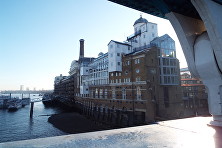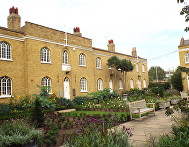





Exploring Southwark and discovering its history


Walworth Town Hall
Walworth Town Hall, on the corner of Wansey Street and Walworth Road has been surrounded by hoardings since a fire caused severe damage in 2013. It looks uninhabited and unused and beside it Elephant Park is growing, ever diminishing the building that served its community for 150 years. Deciding and planning for the future of this Grade II listed building is a slow process, not helped by constraints on funds available to ensure the future of the building.
In 1855, the parish vestry of St Mary Newington was incorporated as a secular local authority in 1855 and dealt with those local matters not dealt with by the Metropolitan Board of Works which had been created in the same year. Vestry matters were conducted in both the Vestry Room in the church and in the infant’s room at St Mary Newington School, accommodation which were described as “inconvenient.” By 1862, as vestry business increased, it was acknowledged and agreed that larger, dedicated premises were required. A year later the vestry secured an agreement for a lease for 99 years from the Fishmongers’ Company for the site on the corner of Wansey Street and the foundation stone was laid at a ceremony in April 1864 by the Chairman of the Vestry. The architect, Henry Jarvis of Trinity Square, laid inside the foundation stone a sealed bottle that contained coins of the realm (a half sovereign, a 2 shillings piece, a one shilling piece, and sixpenny, fourpenny, threepenny, twopenny and one penny pieces), a document that contained the names of the vestry men, and a plan of the building.
The Vestry was formally opened on 8 August 1865 with a ceremony which commenced with a procession led by members of the vestry and school children from St Mary’s School to the new building. The Vestry Hall was described in the Morning Advertiser as having “an ornamental though chaste character which attracts much interest in the locality. Externally the material is coloured brick, with
stone dressings, the windows divided in the centre with elegant polished granite columns having noble sculptured heads and floral decoration. The entrance is very lofty, and the ground floor very appropriately arranged for the requisite offices; from thence a stone staircase leads down to the strong room, which is duly fitted for depositing deeds, records, etc. Upon the upper floor is large committee-room, and the hall below for general vestry and other large meetings, is 42 ft x 40 ft, and 30 feet in height, lit from the centre dome with what is termed ”sunlights” consisting of 81 burners. The whole is tastefully but not extravagantly finished.” Tastes change but in the face of such civic pride in the new building, it seems a bit unkind for Pevsner to dismiss it as “sadly gothic in red brick”.
When in 1900 the parishes of St Mary Newington, St Saviour’s (Southwark Cathedral), St George the Martyr and Christchurch were amalgamated to form the Metropolitan Borough of Southwark, members of the vestry of St Mary’s fought hard that the new borough should be called Newington. While this didn’t happen, Newington Vestry Hall became the town hall for the newly formed borough and the building extended.
In 1965, the Metropolitan Boroughs of Southwark, Camberwell and Bermondsey were combined to form the London Borough of Southwark. Camberwell Town Hall was chosen as the new Borough’s Town Hall, while Walworth Town Hall remained as council offices, offices for The Charity Commission, and after 2006 housed the Cuming Museum.
Walworth Town Hall was Grade II listed in 1996, with Historic England describing the building as the “second oldest of its kind surviving in London, the oldest being Woolwich Old Town Hall of 1842. The style is a subtle blend of French Second Empire and High Victorian Gothic, such as that found more commonly on commercial buildings of the period.”
The fire that broke out on 25 March 2013 was devastating, destroying part of the roof and the Council Chamber, with further water damage to lower floors caused by extinguishing the fire. As noted above, progress regarding the future of the building is slow though a short term lease for Newington Library next door, also closed after the fire having suffered water damage, has recently (October 2017) been granted to Art Academy.
Web discoveries
- UK Casino Not On Gamstop
- UK Casino Not On Gamstop
- Non Gamstop Casino
- Casinos Not On Gamstop
- Non Gamstop Casinos
- Non Gamstop Casinos
- Non Gamstop Casino
- Casinos Not On Gamstop
- Casino Sites Not On Gamstop
- Slots Not On Gamstop
- Casinos Not On Gamstop
- UK Betting Sites Not On Gamstop
- UK Casino Not On Gamstop
- Best Non Gamstop Casinos
- Betting Sites
- Non Gamstop Casino Sites UK
- Best Non Gamstop Casinos
- Non Gamstop Casino
- Casinos Not On Gamstop
- Non Gamstop Casino Sites UK
- Horse Racing Betting